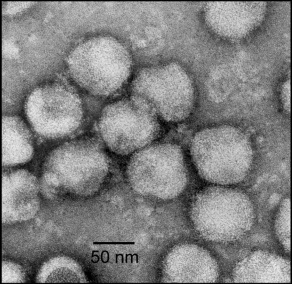The discovery and phylogenetic analysis of four additional mesoniviruses in 2013, named Hana virus, Méno virus, Nsé virus and Moumo virus, has suggested that they represent at least three new species of mesoniviruses.[5] Additionally, in 2014 four potentially new species were discovered in Australia, Indonesia, and Thailand, named Casuarina virus, Karang Sari virus, Bontag Baru virus, and Kamphaeng Phet virus, respectively.[3][6] As of February 2015, these discoveries have yet to be ratified by the International Committee on Taxonomy of Viruses (ICTV).
Structure and genome
The genomes are linear, positive-sense, polycistronic, single-stranded RNA, and are about 20,000 nucleotides in length, with a 3' poly(A) tail and seven major open reading frames (ORFs). Two overlapping ORFs are at the 5'-end, encoding the major non-structural proteins and are expressed as a fusion protein by ribosomal frameshift. ORFs 1a and 1b contain six replicase domains, as well as the 3'-5' exoribonuclease (ExoN) that controls RNA replication fidelity and a 2'-O-methyltransferase, both of which are found in larger nidoviruses. ORF 1b also encodes an N7-methyltransferase.[2][7]
History
The family is relatively new, having only been discovered in 2011. The first virus, which was named Nam Dinh virus, was found in the Vietnamese province of Nam Định.[2] The second virus, named Cavally virus, was then found in Côte d'Ivoire.[7] These two viruses were later found to be of the same species. A third member of this first species, named Dak Nong virus, was later found in Culex tritaeniorhynchus populations in Vietnam.[8] In 2013, four more mesoniviruses were discovered in mosquito populations, all within Côte d'Ivoire,[5] and in 2014 four mesoniviruses were discovered in mosquito populations in Australia,[6] Indonesia, and Thailand.[3]| unranked): | Virus |
| Realm: | Riboviria |
| Phylum: | incertae sedis |
| Order: | Nidovirales |
| Suborders and Families[1] | |
|---|---|
| Electron micrograph of negatively stained NDiV virions | |
| Virus classification | |
|---|---|
| (unranked): | Virus |
| Realm: | Riboviria |
| Phylum: | incertae sedis |
| Order: | Nidovirales |
| Suborder: | Mesnidovirineae |
| Family: | Mesoniviridae |
| Subfamily: | Hexponivirinae |
| Genus: | Alphamesonivirus |
| Subgenera and Species | |

Inga kommentarer:
Skicka en kommentar